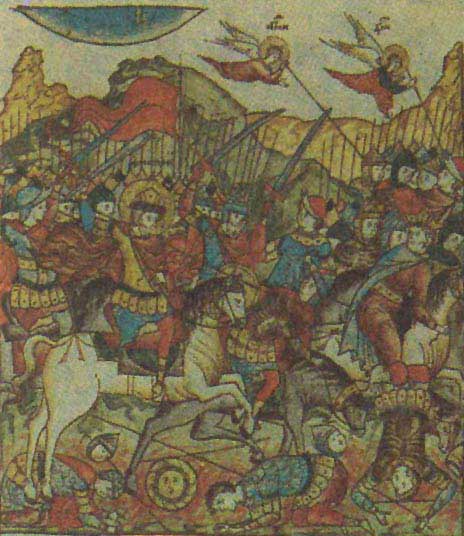|
|||
|
Philatelia.Net / Fragments of Russian History / Plots / The directory «Plots»1380. The Battle of KulikovoThe Battle of Kulikovo was fought by the Tartaro-Mongols and the Russians. The battle took place on September 8, 1380 at the Kulikovo Field near the Don River (now Tula Oblast) and resulted in a Russian victory. Moscow, along with many other Russian lands, was conquered by the armies of Batu Khan, grandson of Genghis Khan in the 13th century, and was made a tribute payer to the Golden Horde. Russian leaders long sought for independence. Under Prince Dmitri Ivanovich, Grand Duchy of Moscow became the most powerful of Russian princedoms. In 1370, Tatar warlord Mamai took the power in Golden Horde and accepted the title of Great Khan. As he wasn't a genghisid, his position remained vulnerable as there were legal descendants of Genghis Khan who could pretend the throne. Mamai sought to affirm his sovereignty over the tributary lands of Golden Horde. In 1378 he sent forces led by warlord Murza Begich to enforce Moscow Prince's obedience. But Horde army was defeated at the battle of the Vozha River and Begich was killed. Two years later Mamai led his armies to Rus himself. Prior to invasion, he made negotiations with Prince Jogaila of Lithuania and Russian prince Oleg of Ryazan, a fierce enemy to Dmitry. The armies of Lithuania and Ryazan were sent to join Tatars. Mamai set his camp on the shore of Don, waiting for allies. Dmitry mobilised his troops and allies in Kolomna to resist the invasion. In Troitse-Sergieva Lavra he met St. Sergius of Radonezh, who blessed the Russian armies to fight. Dmitri knew about approaching armies of Lithuania and Ryazan, and decided not to wait but to attack Mamai immediately before he could be reinforced. On September 7, 1380, Russians crossed the Don. Combined Russian armies under the command of the Grand Prince of Vladimir, Dmitri Ivanovich of Moscow (called "Dmitry of the Don" afterwards) faced a much larger Tatar force under the command of Mamai, a strongman of the Golden Horde. Mamai's allies, Grand Prince Oleg of Ryazan and Grand Prince Jogaila of Lithuania were late to the battle. The old Russian poem Zadonshchina says 150,000 Russians and 300,000 Tartaro-Mongols, but the actual size of the Kulikovo Field would not allow such a quantity of troops. Most likely the figures were closer to 80,000 Russians including seven thousand rebel Lithuanians and 125,000 Tatars. On the morning of September 8, a thick fog covered the Kulikovo Field. The fog cleared around 11 A.M, at which point both armies began simultaneously advancing on each other. The battle was allegedly opened by a single combat of two champions. The Russian champion was Alexander Peresvet, a monk from the Trinity Abbey sent to the battle by Saint Sergius. The Horde champion was Temir-murza (also Chelubey or Cheli-bey). The champions killed each other in the first run, though according to Russian legend, Peresvet did not fall from the saddle, while Temir-murza fell. After approximately three hours of battle (from noon to 3 p.m.) the Russian forces were successful, although suffering great casualties, in holding off the Horde's attack. The cavalry of Vladimir, Prince of Serpukhov (Dmitri's cousin), led by Dmitri Bobrok, Prince of Volynia launched a flanking surprise counter strike and achieved victory over the Horde forces. Mamai escaped to Crimea, where he was assassinated by his enemies, leaving the Horde under the command of Tokhtamysh. This victory was the beginning of the end of the Mongol yoke, which officially ended with the great standing on the Ugra river a century later. Its spiritual importance for the unification of the Russian lands was even more important. As one historian put it, the Russians went to the Kulikovo Field as citizens of various principalities and returned as a united Russian nation. This view, however - made from the perspective of later Russian history - was possibly not shared at the time by the prince Oleg of Ryazan who allied the losing side. Ukraine, 2005, Voevoda Bobrok Volynets. Kulikovo Field Russia, 2010.09.18, Russia, 2009, Advertising: |
|||
© 2003-2024 Dmitry Karasyuk. Idea, preparation, drawing up
|

